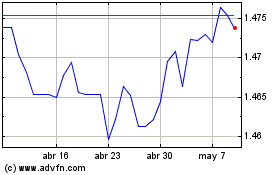Commodity Currencies Drop As Asian Stock Markets Traded Lower
07 Octubre 2024 - 9:23PM
RTTF2
The commodity currencies such as Australia, the New Zealand and
the Canadian dollars weakened against their major currencies in the
Asian session on Tuesday, as Asian shares traded lower dragged by
the tumbling Hong Kong market. Traders also reassessed their
expectations for the outlook on interest rates after upbeat U.S.
jobs data. Escalating tensions in the Middle East is also weighing
on market sentiment.
The Australian dollar fell after the remarks made by Zheng
Shanjie, the chairman of China National Development and Reform
Commission at the press conference. The investors were disappointed
over the lack of concrete information regarding the extent of
Beijing's newly announced stimulus program.
Traders also now cautiously await readings on U.S. consumer
price and producer price inflation later in the week for further
cues.
On the geopolitical front, Israeli defense forces intensified
air strikes targeting Gaza and the Lebanese capital of Beirut
simultaneously on the first anniversary of Hamas' cross-border
attack in Israel, which triggered the Middle East war.
The Reserve Bank of New Zealand (RBNZ) is due to announce its
monetary policy decision on Wednesday, where markets widely
anticipate it to cut interest rates by 50 basis points to 4.75
percent. In the Asian trading now, the Australian dollar fell to
more than a 2-week low of 1.6341 against the euro, a 6-day low of
99.09 against the yen and a 4-day low of 1.0988 against the NZ
dollar, from yesterday's closing quotes of 1.6239, 100.13 and
1.1030, respectively. If the aussie extends its downtrend, it is
likely to find support around 1.65 against the euro, 96.00 against
the yen and 1.08 against the kiwi.
Against the U.S. and the Canadian dollars, the aussie slipped to
more than 3-week lows of 0.6715 and 0.9155 from Monday's closing
quotes of 0.6757 and 0.9200, respectively. The aussie may test
support near 0.65 against the greenback and 0.90 against the
loonie.
The NZ dollar fell to nearly a 3-week low of 1.7967 against the
euro, from yesterday's closing value of 1.7914. The next possible
downside target is seen around the 1.81 region.
Against the U.S. dollar and the yen, the kiwi slid to nearly a
4-week low of 0.6108 and a 6-day low of 90.12 from Monday's closing
quotes of 0.6124 and 90.75, respectively. If the kiwi extends its
downtrend, it is likely to find support around 0.59 against the
greenback and 88.00 against the yen.
The Canadian dollar fell to 4-day lows of 108.21 against the yen
and 1.4966 against the euro, from yesterday's closing quotes of
108.80 and 1.4942, respectively. If the loonie extends its
downtrend, it is likely to find support around 104.00 against the
yen and 1.52 against the euro.
Against the U.S. dollar, the loonie edged down to 1.3635 from
Monday's closing value of 1.3616. On the downside, 1.37 is seen as
the next support level for the loonie.
Looking ahead, U.S. Sep NFIB business optimism index for
September and U.S. and Canada trade data for August, are slated for
release in the New York session.
Euro vs CAD (FX:EURCAD)
Gráfica de Divisa
De Nov 2024 a Dic 2024

Euro vs CAD (FX:EURCAD)
Gráfica de Divisa
De Dic 2023 a Dic 2024
